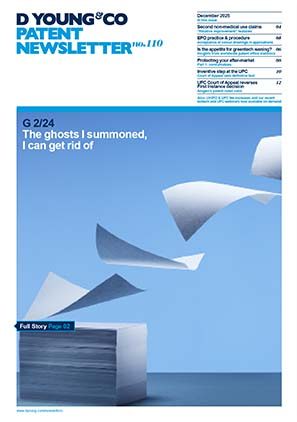T 56/21: the ongoing saga of description amendments
The European Patent Office (EPO) stands alone as the only patent authority that requires amendments to be undertaken, prior to grant, to bring the description in line with the scope of the allowed claims. This is a time-intensive and, therefore, a cost-intensive obligation that raises a number of potential risks, including added matter, reduced protection in national jurisdictions under the doctrine of equivalents, along with potential implications for claim interpretation.
The requirement has been justified by the EPO on the grounds of increased clarity and consistency, particularly for third parties. However, it has been argued that this requirement places an undue burden on applicants and fails to find legal basis in the European Patent Convention (EPC). Although description amendments are currently required by EPO practice, there has been diverging treatment in case law, with some Boards of Appeal treating description amendments as mandatory under the EPC and other Boards of Appeal disagreeing.
Examples of decisions where a Board of Appeal has treated description amendments as mandatory include T 1024/18, T 2766/17, T 2293/18, T 121/20, T 1516/20 and T 3097/19. Examples of decisions where a Board of Appeal has not treated description amendments as mandatory include T 1989/18, T 1444/20 and T 2194/19.
The ongoing case of T 56/21 is one in which the patentee has appealed against the decision of the examining division to refuse EP 15700545.5 in the absence of description amendments.
This article briefly reviews the description amendment landscape and comments on T 56/21.
EPO Guidelines for Examination
Historically, relatively minimal description amendments were required under European practice. However, requirements have become increasingly onerous, crystallising in the 2021 version of the EPO Guidelines for Examination. The latest version of the guidelines, released in March 2023, state that applicants should delete subject matter no longer covered by the allowed claims or explicitly state that such subject-matter does not fall within the scope of the invention. Furthermore, claim-like clauses should be deleted on the basis of inconsistency with the scope of protection, leading to lack of clarity, irrelevancy, or unnecessary duplication.
The EPO Guidelines for Examination provide instructions on the practice and procedure to be followed, but are not legally binding on the EPO Boards of Appeal. Hence the legal basis for the description amendment requirement is an issue of ongoing debate in the case law.
Those Boards of Appeal in favour of description amendments have found support in Article 84 EPC as well as Article 69(1) and Rules 42(1)(c) and 48(1)(c) EPC. These provisions will be discussed in turn.
Article 84 EPC
Article 84 EPC provides, first, that the claims shall define the subject matter for which protection is sought and, second, that the claims shall be clear and concise and be supported by the description.
Where Boards of Appeal have not considered description amendments mandatory, it has been emphasised that Article 84 EPC requires the claims to be clear in-and-of-themselves, without reference to the description (for example, T 1989/18, Reasons 4-5). The support for claims in the description is also noted as being required only to the extent that the claims should not include subject matter that does not have basis in the description. As such, additional subject matter in the description that does not appear in the claims is not prohibited and should not give rise to inconsistency. Furthermore, where the claims are clear, no lack of clarity arises from further embodiments in the description.
In contrast, where Boards of Appeal have considered description amendments mandatory, it has been held that the requirements of clarity and support are separate and that merely providing a part of the description which gives support to the claims appears at odds with the support requirement of Article 84 EPC (T 1024/18, Reasons 3.1.8-3.1.9). However, the reasoning behind this position seems circular.
In addition to the legal basis in Article 84 EPC, there appears to be tension between case law in which clear claims are treated as self-contained in the context of claim interpretation, such that the description cannot be used in determining definition of subject-matter, (for example, T 1473/19, T 1127/16, and T 169/20) and case law treating claims (and the scope of protection conferred thereby) as capable of being rendered unclear if the description is not amended in line with the allowed claims.
Article 69(1) EPC
Article 69(1) EPC provides that the extent of protection afforded by a European patent shall be determined by the claims and allows the description and drawings to be used to interpret the claims. Where Boards of Appeal have not considered description amendments mandatory it has been held that this article is not concerned with the definition of the subject-matter sought to be protected by a claim, rather it determines how the claims should be interpreted to determine the scope of protection and is thus not relevant to description amendments (T 1989/18, Reason 6).
In contrast, where Boards of Appeal have considered description amendments mandatory, it has been reasoned that as the description is used to interpret the claims under Article 69(1) EPC, the claims only clearly define the scope of protection pursuant to Article 84 EPC, if they are not inconsistent with the description (T 3097/19, Reasons 27-34). It has been further reasoned that where there is inconsistency the skilled person would be confused regarding the scope of protection.
A particularly fraught issue appears to be whether in order to be supported under Article 84 EPC it is enough that the subject matter of the claims is found in the description, or whether it is necessary that all embodiments are encompassed by the scope of the claims and only such embodiments are present (or otherwise marked). As the EPO is not involved in enforcement and does not determine the scope of protection afforded by the claims, it is perhaps questionable whether the EPO should be at all involved in indicating embodiments that the claims do or do not encompass.
Rule 42(1)(c) EPC and Rule 48(1)(c)
Rule 42(1)(c) EPC concerns the content of the description and requires that the invention be disclosed in a manner that allows the invention and the advantages thereof to be understood. Rule 48(1)(c) EPC concerns prohibited subject matter and requires that an application does not contain obviously irrelevant or unnecessary subject matter.
These rules have not been cited frequently by Boards of Appeal supporting description amendments. However, Boards of Appeal not supporting description amendments have pointed out that the aim of Rule 42(1)(c) EPC is to ensure that the invention can be understood and that a requirement to adapt the description is simply not what this provision says (T 2194/19, Reason 6.2.3). It has also been observed that contravention of Rule 48(1)(c) EPC is not seen to provide sufficient reason for refusal of an application. Accordingly, it would be counterintuitive to treat this rule as justifying refusal of a patent (T 1989/18 and T 1444/20).
In T 56/21, recognising the divergence in case law, a communication from the Board of Appeal has requested the appellant’s comments on a potential question to be referred to the Enlarged Board of Appeal. The proposed referral question reads:
“Is there a lack of clarity of a claim or a lack of support of a claim by the description within the meaning of Article 84 EPC if a part of the disclosure of the invention in the description and/or drawings of an application (e.g. an embodiment of the invention, an example or a claim-like clause) is not encompassed by the subject-matter for which protection is sought (“inconsistency in scope between the description and/or drawings and the claims”) and can an application consequently be refused based on Article 84 EPC if the applicant does not remove the inconsistency in scope between the description and/or drawings and the claims by way of amendment of the description (“adaptation of the description”)?”
The Board of Appeal acknowledged that EPO practice and early case law “is difficult to reconcile with the case law on clarity requiring that claims should be clear in themselves without having to resort to the description for an interpretation” (Reason 3.1).
The Board of Appeal also expressed the opinion at reason 3.2.2 that:
“Article 69 EPC and the Protocol on the Interpretation of Article 69 EPC concern the effects of European patents (and applications) in the Contracting States. It is not for the Office to harmonise the extent of protection conferred by European patents (and applications) by bringing the description and/or the drawings of any application or patent in agreement with the amended claims held allowable.” (Emphasis added)
Interestingly, T 56/21 involves the same Board of Appeal 3.3.04 and the same applicant as T 1989/18 cited above. The legal board member is also the same as in both T 1989/18 and T 1444/20 cited above. The applicant has three months in which to file observations or submit claim amendments (with the latest date for filing falling on 31 October 2023).
An Enlarged Board of Appeal decision providing clarity on this matter would be welcomed.
Useful links
- Guidelines for Examination, Part F: The European Patent Application, Chapter IV – Claims (Art. 84 and formal requirements), 4.3 Inconsistencies: dycip.com/epo-guidelines-inconsistencies
- Guidelines for Examination, Part F: The European Patent Application, Chapter IV – Claims (Art. 84 and formal requirements), 4.4 General Statements, “spirit of the invention”, claim-like causes: dycip.com/epo-guidelines-general
- European Patent Convention, 17th edition, November 2020: dycip.com/epc-17


